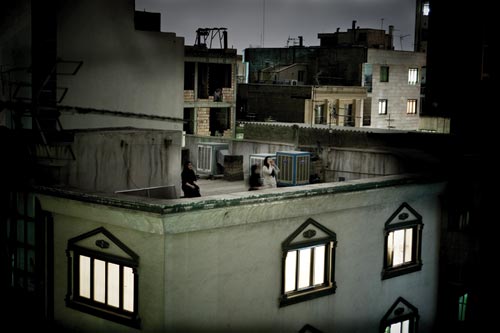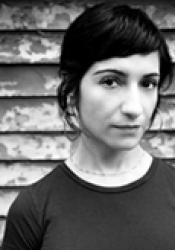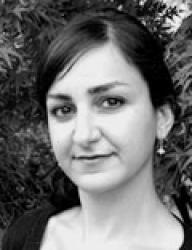What is the genesis of art in a repressive society? In Iran, repression has ruled in one form or another for the last half century and still, the voice of the people rings out around it. As Iran’s recent manifestations of state power take a brazen and unapologetic turn, the creative spirit of the populace has come forth—in poetry, comics, music and prose, blogs, and photography—its pulse beating strongly amid the bloodshed.
In the aftermath of the June 2009 elections the men and women of Iran did not pick up guns or knives, did not fashion small homemade explosives, did not terrorize mosques or public spaces. No, they took to the streets and joined their voices in chants while the streets filled rapidly with militia and police forces, tear gas, and batons. The protesters marched in silence, held placards, calligraphy of poems by Rumi, by Shamlu, and poems from the new generation.
You’re just riffraff, lower than dirt.
I’m the aching lover, blazing and lit.
You’re the black halo, oppressive and blind.
I’m the brave hero and this land is mine!
At night when the infamous smog of Tehran gave way to layered darkness, the same people gathered on rooftops and chanted God’s name—captured in Pietro Masturzo’s haunting and beautiful long exposure photographs. And through this chanting, all that they couldn’t say on the streets was heard. All one needed to decipher the unsaid was to listen to the cadence, the tone, the spaces and silences in between the words. Of course, this wasn’t the first time that words had been used as tools of change for the people of Iran; thirty years ago the same rooftop chants and carefully constructed placards had heralded the end of the Shah’s corrupt, puppet monarchy. The irony of using the same chants as protest against the Islamic regime was not lost on anyone, least of all the heads of power. Afraid of losing face—perhaps one of the biggest forces in Iranian culture, the fear of being publicly shamed—those in power unleashed their drones in larger numbers into the streets and squares (and on a few occasions all the way up to the rooftops to silence the chanters and their calls to God). Such is the power of the word, and the fear it provokes, in a repressive society. In this symposium we are proud to showcase the work of some of Iran’s bravest and most important artists—especially its women writers.
In a place where a woman wears one face at home and another on the street, where gardens are kept from view by high marble walls and where families go to great lengths to draw no shame, how does one tell an illicit tale? Have a controversial opinion? Hold an independent thought? Add to this a deafening public silence wrought by decades of state censorship—whole regimes of panels and boards whose only job it is to comb through all media in search of the slightest infraction against the tenants of the Quran. These “infractions” are often deliberate misinterpretations, and often imagined, depending on the mood of the current regime. How is a poem born in a land like this? All obvious meaning must be dismantled and words that served one purpose must be played with, woven, and disguised to serve another. Language must be reinvented and meaning coded. In the last fifty years the literature of Iran has done just this. Writers have created a world of allusion and metaphor where the tension between what is shown and what is not pulls the reader into a labyrinth that mirrors this repressive society.
In both the time of the Shah and the Islamic Republic that followed, poets, journalists, essayists, novelists, photographers, filmmakers, songwriters, and painters have lived and worked under the thick blanket of censorship. Many fled and continue to flee, but the thinkers and artists who stayed faced the absurdity of having been imprisoned and persecuted by both the Shah’s regime and the Islamic Republic, and yet they have continued to create, to voice their dissent, to devise an elevated language of codes. For this symposium we were able to gather a small sampling of these voices, in poetry, fiction, letters and essay, that show just how resilient art is in the face of oppression, and how, in order to understand a coded society, the word might just serve as the key.
The repercussions of not speaking in codes are real and dangerous: Shahryar Mandanipour was placed on a bus with a group of writers and journalists, only to realize that the bus driver, in on a conspiracy to kill all on board, had jumped out of the vehicle and sent it careening over a cliff. Those who survived the crash were arrested on site. Though he does not write about the incident in the short story “If You Didn’t Kill the Cuckoo Bird,” his setting is the prison cell, and his prose is filled with illogicality and coded imagery of totalitarian rule. Kamin Mohammadi’s tender recounting of navigating love, in a place where privacy is an insult to family and an offense to the state, gives readers an intimate glimpse inside the day-to-day lives and struggles of the twenty-five million youths in Iran. In Fatemeh Shams’ letters to her imprisoned husband, the public and the private, the political and the personal meet in an unmitigated, raw, and tangible way: through a woman’s longing for her imprisoned husband. It is behind the guise of a woman’s desire for an absent beloved that Forough Farrokhzad is able to speak of the years after the 1953 coup d’etat that overthrew the democratically elected Mossadegh in her poem “After You.” It is, perhaps, because of this fear of inherited and unending violence that Roya Zarrin finds swallowing her children the only avenue for protecting them in her poem “Should I Have Known.” This is after all, a society where “the poets become refugees.”
The turmoil in Iran continues and history slowly unveils herself. Unlike the news reports and headlines, the work here—published on the anniversary of last year’s startling demonstrations—is not limited to this particular moment in Iran. It represents a continuum of resistance, frustration, beauty, and love. The work in this symposium tells a particular truth, one that supersedes the machinery of personal and private repression; it reveals the limitation of the sound bite and the Twitter feed and stretches out to tell the long story. What is the future of a people whose first instinct is to take to the riotous streets with verse? Read into these pieces, decode their beauty, listen to the rhythms, and you will be let into the lives behind the high garden walls, the prison gates, far past the censors and the age-old patriarchies, into a world of voices that have been speaking, chanting, whispering their hearts’ desires for a very long time.










